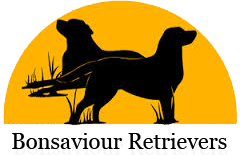
Raw Food for Puppies: How to Feed Your Puppy on Natural Raw Food
In this post, we answer your questions on using raw food for puppies. We also discuss everything from how much to feed and how often. Plus, what types of meat to give your puppy, and how to make a balanced diet.
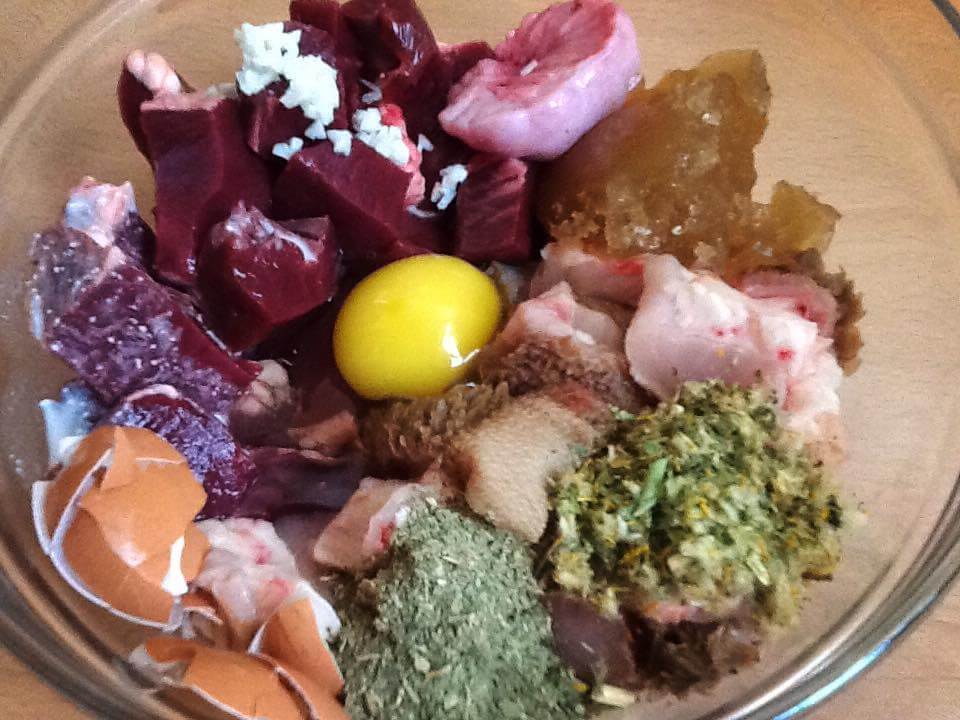
Whilst most dogs nowadays feed on commercial kibble, there is a growing interest in raw food for puppies
What Are the Available Raw Foods for Puppies?
A diet of raw meaty bones (RMB) or biologically appropriate raw food (BARF) is an increasingly popular way to feed dogs. While RMB is pretty self-explanatory, you may wonder what exactly BARF means.
The BARF diet encompasses feeding 60% raw meaty bones and filling the remaining 40% with other raw foods. These may include grains, vegetables, legumes, and other animal proteins as we will see.
Today, though we’ll focus on the HOW of raw feeding, rather than the IF or the WHY. Let’s just first recap why we might choose to use raw food for puppies.
The Aim of Raw Feeding Your Puppy
A dog’s digestive system is designed for processing meat and bones. However, dogs have associated with humans for ages.
As a result, they can now digest many additional types of food. That’s why it is possible to feed a puppy on processed commercial food too.
Despite the fact that the dog has adapted to eating a wider range of food, his digestive system is still ideally suited for processing carcasses. The aim of raw feeding, therefore, is to give your dog a diet made for them as a carnivorous animal.
Dogs have the powerful crushing jaws, strong stomach acids, and short meat-eaters digestive tract to process a completely natural raw diet.
Raw Food for Puppies: Rules and Principle
If you choose to feed raw, you need to understand the principles involved and follow some basic rules to keep your puppy safe and healthy.
Even for animals perfectly designed for crushing and swallowing bones, there are certain risks involved. And it is important that we minimize those risks in any way possible.
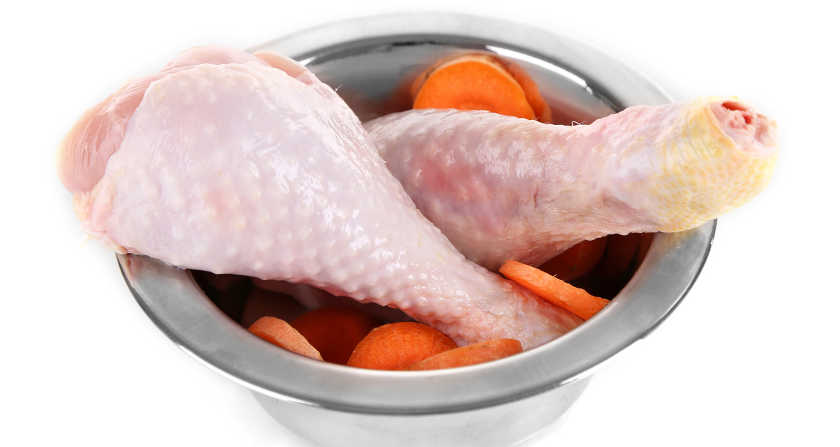
Safely Using Raw Food for Puppies
Before we go any further, let’s talk a moment about safety. Because whichever way you decide to feed your dog, it makes sense to reduce any risks to an absolute minimum.
One way to do this is to buy an off-the-shelf raw food.
But many raw feeders want to make their own food at home. So let’s look at what you can do to feed raw in the best way.
It is a good idea to follow these feeding practices if you are going to raw feed your dogs. This is doubly important with puppies.
Rule One – Feed Fresh Meat to Your Puppy
Once an animal is dead, its flesh begins the process of decay.
As part of this process, the pathogens in meat will increase naturally over time, unless it is frozen. So be sure to freeze meat soon after purchasing or refrigerate it below 4 C and use it within a couple of days.
Older dogs can often cope with pathogens that would make humans ill. Puppies, however, are more vulnerable. Only feed them the freshest meat that you would feed your own family.
Rule Two – Handle and Store Raw Meat Safely
One of the main risks of feeding raw is not to your dog, but to you.
Handling raw meat, especially chicken, is always risky. Raw chicken especially is typically contaminated with bacteria such as salmonella. That’s why eating chicken that is raw or not cooked through can make you sick.
You can reduce this risk in a number of ways.
Careful Storage:
Store raw meat in covered containers, separate from your other food and well away from foods eaten raw (like salads).
We like these fridge containers from Amazon with clip-on lids. Of course, you can use any container with a lid that is dishwasher proof or can be washed in hot water.
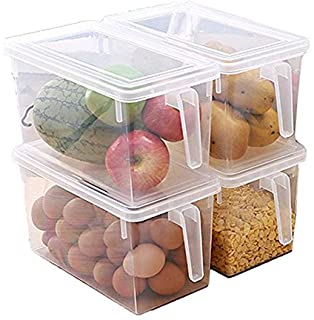
Dedicated Cutting Boards:
Cut up raw meats on dishwasher safe dedicated chopping boards. Remember that you should use these boards for nothing else, but cutting raw meat.
Use dedicated knives too, and wash both in a dishwasher or very hot soapy water.
Protect Your Hands:
Wear disposable latex gloves to handle meat and throw them away when you have finished.
Then wash your hands thoroughly with warm soapy water. The Center for Disease Prevention and Control recommends 20 seconds at least, of handwashing after.
Rule 3 – Protect Your Puppy’s Teeth From Hard Bones
Raw feeding offers both benefits and risks to your dog’s teeth.
The major benefit is clean teeth—a result of the abrasive cleaning actions of processing bone.
The main risk is tooth damage. This can include serious fractures of the teeth requiring expensive dental treatment and involving pain for your dog.
Fortunately, this risk can be largely avoided, by the following:
Avoid Weight-bearing Bones of Large Animals
Avoid feeding your puppy weight-bearing bones of any large animal, such as cows, sheep, etc.
Weight-bearing bones are the bones the animal stands on. They include the long bones in the legs that carry all of its body weight. It is, however, OK to feed leg bones of small animals to most dogs. So, make sure to feed bones that are proportional to your dog’s size.
Think about the size of animal a small to medium-sized dog might be able to catch and consume on his own. If your dog is medium to large-sized, this may be a rabbit, for example. That should be the largest size of animal to feed whole to your dog.
Very tiny dogs may need even smaller bones. Chicken wing tips for example, rather than the whole “arm” of the bird.
That does not mean you can’t feed beef bones to most dogs—you can. But choose bones that do not support the animal’s body weight, like ribs for example.
Rule 4 – Feed Your Puppy a Wide Variety of Meats
Puppies need sufficient nutrients to keep them healthy and provide for their rapid growth. The best way to provide those nutrients is to offer a wide variety of nutritious food.
It is very tempting to just feed what is easily available at the time. Many raw feeders are overly reliant on chicken because it is easy to obtain, but this is not sufficient, especially for puppies.
Here are some ideas for what you can and should give your puppy
What Is the Best Raw Food for Puppies?
If you make sure that your puppy has access to the following raw ingredients, at least once or twice each week, he should be able to access the nutrients he needs:
-
Eggs
-
Green tripe (stomach of herbivore)
-
Oily fish
-
Beef or lamb ribs with plenty of meat on them
-
White fish
-
Chicken backs, necks, wings and feet
-
Pigs trotters
-
Kidney, heart, lungs (of cow, pig, sheep)
-
Liver (tiny quantities)
Eggs make a great raw food for puppies. Some dogs will eat the shell too, which is fine. You may have to whisk the egg slightly the first few times you feed, to get the puppy started.
There is no truth to the myth that pork is poisonous to dogs. It is fine to feed puppies pig feet, meat, and organs.
Remember to avoid those large weight bearing bones as these are very hard and may damage your puppy’s teeth.
Can Puppies Eat Vegetables?
Dogs in the wild eat the stomach of their prey and some of its contents, which may include digested vegetation. They may also consume fallen fruit, berries, and so on at certain times of the year.
Tripe is the stomach of a herbivore – usually a cow or a sheep. Green simply means “unwashed.” If you feed your dog “green” tripe, he will benefit from the minerals in the remains of the semi-digested material. On the other hand, humans typically eat white tripe. This kind has had all these important nutrients washed out of it, so it isn’t beneficial for your dog.
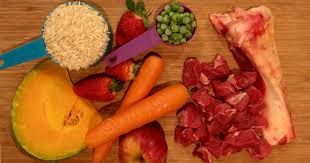
Feeding green tripe and whole prey animals (whole rabbits, fish, etc.) intermittently is healthy. It will give your puppy access to the range of nutrients he needs. If your puppy’s diet is more restricted, and you don’t feed green tripe regularly, you’ll need to supplement your dog’s food with some vegetables.
Ensure that these are pureed (mashed) or liquidised. (It is no use giving green vegetables whole, as your dog cannot digest them effectively).
Some people like to feed fruit and vegetables (carrots, for example) to their raw fed dogs as snacks. This is not a problem provided you are aware of which common human foods are toxic to dogs. (Onions are, for example).
How to Prepare and Serve Your Puppy’s Raw Food
Don’t Cut Food Up Too Small
If you cut up meat on the bone, your puppy may swallow large lumps of bone without first breaking them properly.
How small an item you can feed will depend on the size of your puppy. For example, take a Labrador puppy of three or four months old. He may be able to swallow a chicken wing whole if you feed just the last two joints. So it is best to feed the whole wing of a big chicken, or to feed a larger portion such as the back of the carcass.
That way he has to work on the wing to break it down before he swallows it.
Don’t Crowd Your Puppy While He Is Eating Raw Meat
It is best not to stand over your puppy while he is eating raw meaty bones.
The idea is to avoid the dog “gulping” down large lumps of bone at once. They are more likely to do this if they think you are going to take their food away. So let your puppy eat in peace.
This can lead to the puppy gulping down larger quantities of bone than he can digest, instead of breaking it up with his teeth.
Raw meat is very valuable to dogs. You can understand why they may worry you’ll take it away if you hang around while they eat.
Feed Your Puppy Enough Bone!
Many people rely on ground (minced) meat and steak. No wonder; they’re easily found in local shops and supermarkets.
But feeding puppies ground up beef or steak is not a suitable diet. They need bone and connective tissue in their diet. So, ground meat alone will leave them deprived of minerals, and won’t protect their teeth.
Don’t be scared of bone. If you can’t bring yourself to feed bone, raw feeding is not going to work for your puppy.
How Much Bone Does My Puppy Need?
Puppies need a substantial proportion (at least 10%) of their diet to be bone.
You can buy pet foods that contain minced bone, and it’s ok to use these as part of your puppy’s diet. But he needs to chew on actual bone to benefit from the dental hygiene aspects of a raw diet.
A dog that eating enough bone will produce firm stools that crumble when dry. If your dog’s stools are loose he is probably not getting enough bone. Too much offal will also produce loose stools.
If your puppy’s stools are hard and difficult to pass, you are probably feeding too much bone. It might be best to cut back a little.
Let Your Puppy Chew Up His Raw Food
Don’t rely on ground meat to feed your youngster, even if it has been minced with bone in it.
Grinding or mincing meat isn’t wrong per se. But don’t teach your puppy to rely on you instead of his own teeth and jaws.
Mincing your eight-week-old puppy’s green tripe, for example, is fine. But as soon as he is big enough to manage to tear chunks off by himself, let him do so.
How Much Water Do Raw-fed Puppies Need?
Raw-fed dogs drink a lot less than kibble-fed dogs do.
However, water is still essential.
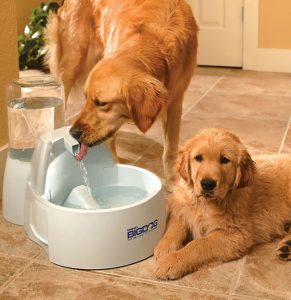
Always ensure your dog has plenty of fresh water to drink. This is especially important when your dog has consumed a lot of bone.
He will drink as much as he needs.
Your dog will be fine with a regular water bowl, provided you keep it clean and well filled
How Much Raw Food for Puppies?
As always, when feeding puppies, be guided by your dog, rather than a set of scales. You should be able to feel ribs, but not see them. And your puppy should have a waist.
As a rough guide, many puppies will need to eat the equivalent of 2-3% of their expected adult weight, every day.
So if you have a labrador puppy, feed him according to what he might be expected to weigh as an adult (around 60lbs). This would amount to just over 1 lb of food each day.
But don’t forget, the “average” puppy doesn’t really exist. Each puppy is different and will grow and eat at his own pace.
Fat Puppies
Puppies fed raw are far less likely to be fat, and much more likely to stop when they’re full. It is difficult to overfeed using raw food for puppies. So if you want to give your puppy a little more because he seems hungry, then by all means.
Just keep an eye on that waistline, and cut back for a few days if he starts to get plump.
Thin Puppies
If you think your puppy is looking a little thin, despite being fed as much as he wants, think intestinal worms.
You should deworm him regularly with a puppy deworming medication from your vet. You can also find them on online veterinary pharmacies. There is NO truth in the myth that raw fed puppies don’t get worms.
At the time of writing, fenbendazole is considered very safe. You should always check with your vet before deworming your puppy or dog for the first time.
Deworming Your Puppy
The thought of deworming your dog may sound gross to you, but it is a necessary evil. Dogs can become infested with different kinds of worms. The most common is the roundworm, but they can also have tapeworms, hookworms, and whipworms.
Besides weight loss, a worm-infested pup may also vomit or experience diarrhea. Be sure to see your vet to check their feces and choose an appropriate dewormer. Panacur is the dewormer I use for my puppies. The active ingredient is fenbendazole, and there are a range of products based on it including the popular brands "Drontal" or "Panacur".
After deworming, your dog may pass the dead worms in his feces, (looks like spaghetti). Some dogs may also experience vomiting.
Other dogs with heartworm may be at risk of pulmonary thromboembolism after deworming. This happens when the killed worms block the dog’s arteries. That’s also why your vet should make sure which worms your pup has before deworming.
But try not to worry; your pup should be good as new soon after.
How Often to Feed Your Puppy
Don’t try to give your puppy his whole day’s ration at once.
Divide the daily ration into four portions for puppies under three months old. Do three portions for puppies between three and six months of age. And for pups six month to 1 year old, do two portions.
Spread these meals out over the day at three to four hourly intervals. You don’t have to stick to these guidelines rigidly, and raw fed puppies may not want to eat as frequently as kibble fed pups.
If your three-month-old puppy only wants to eat twice a day and is thriving, then that is OK.
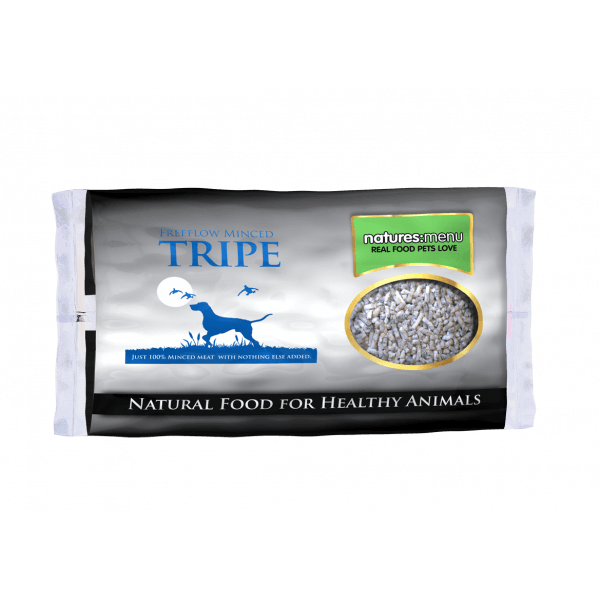
Adult Dogs and Fasting
Adults can eat once or twice a day. It is up to you and your dog. Don’t forget that dogs in the wild may go long periods without eating, then eat a LOT of meat and bone in one go.
Your adult raw fed dog won’t come to any harm if you miss a day’s food and give him extra the next day. In fact many experts believe that occasional fasting is beneficial for you dog.
However, do NOT fast a dog on kibble, then allow him to gorge on extra rations the next day. Kibble is not designed to be consumed in large quantities, and your dog is not designed to process it that way.
How to Start Using Raw Food for Puppies
If your puppy is currently being fed on kibble and you want to make the switch, you’ll be excited to make a start.
But it’s important to take this one step at a time. Don’t just plunge in with a medley of foods. Lots of new foods all at once may trigger a tummy upset.
Start with one food. Chicken is usually well tolerated. Feed a meager amount at the first meal, and if all is well, slightly more at the next. After a couple of days, add another food—eggs for example, or tripe.
The rule is: small quantities at first, increasing gradually at each mealtime.
Of course meal variety is important. But a healthy puppy won’t starve or suffer from deficiencies over just a few days.
And this gradual introduction will allow his stomach and digestive system to get used to his new way of eating.
Raw Food for Puppies on a Budget
We all want the best for our dogs. So it is likely that after reading this, you really want to start using raw food with your pup. Except, you have one issue: your budget is pretty low.
Trust me, we’ve all been there. Thankfully, it’s not impossible to give your dog some healthy raw food on a budget. We’ve found these three tips to be super helpful:
-
Skip the prepackaged raw foods: Make your own raw food plates for your dog instead.
-
Shop for cheaper animal parts: This was an eye-opener for me! Parts like chicken feet, chicken necks are less expensive and may fit in your budget.
-
Use dog-safe vegetable peelings: Be sure to only pick fruits and veggies safe for dogs.
Good luck with using raw food for puppies.
References
-
VetStreet. Khuly, Dr. P. VMD, Are Dogs Carnivores? Here’s What New Research Says
-
VetStreet. Becker, Dr. M. VMD, Can I Treat My Dog’s Worms Myself?
-
DrBarchas.com. Barchas, Dr. E. VMD, Roundworms (Intestinal Worms) in Cats and Dogs
-
Centers for Disease Control and Prevention. Chicken and Food Poisoning
-
Veterinary Medicine and Science. Craig, J. M. (2016), Atopic dermatitis and the intestinal microbiota in humans and dogs.

We at Bonsaviour strongly believes in a Raw Natural Diet for True Health of the Dog,
We offer help and advice on the correct diet for the In-Whelp Pregnant Bitch, naturally rearing healthy puppies, adult dog diet and the older dog diet.
Dogs fed naturally as nature intended with the addition of vital herbal minerals and vitamins will keep your dog in excellent health and ailment free throughout their life.
Bonsaviour has practiced the Natural Diet for the dog for more than 25 years.
Dogs in the wild would naturally kill their own prey, this is the reason why raw meat and raw bones is a natural diet for the domestic dog as like their ancestors. Domestic dogs and wolves have exactly the same strong digestive tract, the prey, (example the rabbit) the dog will eat the cereal content of the stomach, the prey would of raided the farmers crops thus why the cereal is part of the dog's diet, the fur would be the roughage, we replace this with bran it helps the anal glands to empty naturally.
Commercialized unnatural dog foods can cause health problems in dogs especially as the dog ages.
Feeding your dog raw foods the natural way as nature intended combats these problems.
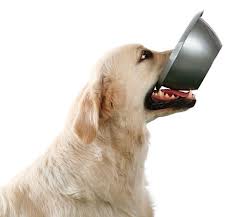
Bonsaviour Dog Breeder for Golden Retriever Puppies & Stud Dog
Bonsaviour Tripe Diet
Dogs were in existence long before the creation of dried dog food. So how could they have possibly survived. In the wild a dog will catch it's food and devour nearly all of it, the flesh (good source of protein), fat (a good source of energy), bone (good source of calcium), muscle and organ meats, and the stomach with its contents (a good source of enzymes, minerals and pre-digested plant material consisting of herbs and grasses).
Dogs, both domesticated and wild, are members of the carnivore family. Anatomically, they are built for it. No one describes this more eloquently than Juliette de Bairacli Levy in her book, The Complete Herbal Book for the Dog A Handbook of Natural Care and Rearing:
The dog is a meat eater, from the teeth fashioned for tearing and crushing, the powerful jawbones and muscles, the small, very muscular stomach, the short intestines and above all the very powerful digestive juices peculiar to the carnivorous animals - digestive juices that can dissolve even lumps of bone. In health, the dog's juices, both of mouth and stomach, are strongly antiseptic, and thus high meat and even flesh from diseased animals food which would kill a human being in a day, can be eaten without any harmful effects.
Ms. Levy's philosophy of raising dogs is called Natural Rearing and it means just what it says raising the dog in such a way as to reproduce the way they would exist in their natural state.
Natural rearing diets, such as Raw Food, also known as, Bones And Raw Food), are based on fresh foods such as raw meats, raw bones, raw vegetables and herbs. Because dogs in the wild would not eat every day, one day of fasting (only for adult dogs) per week is also recommended. This allows the animal to cleanse its body of toxins.
Cooking breaks down many of the proteins and amino acids in raw meat, thus destroying much of it's nutritional value. The dog being not only a hunter, but a scavenger as well, will be able to exist on a diet of cooked food, but it will not be in optimal health. I guess a similar comparison would be to place a human being on a strict diet of only MacDonalds hamburgers and fries for the rest of his/her life!
Raising your dog on poor diets will eventually have its effect - disease, immune deficiencies, short life span, the list is endless. Thanks to the works of Juliette de Bairacli Levy, Dr. Ian Billinghurst, Wendy Volhard and Dr. Kerry Brown, Dr. Tom Lonsdale and Kymythy Schultz a step in the right direction (back to nature) has been taken. Their books have been and invaluable source of information for all dog owners.
REFERENCES:
The Complete Herbal Book for the Dog, Juliette de Bairacli Levy
Give Your Dog A Bone, Dr. Ian Billinghurst
The Holistic Guide For A Healthy Dog, Wendy Volhard & Kerry Brown, DVM
I am sure you are thinking, "...what is Green Tripe?". The answer to that is simple, because it is the best, most natural food you could feed your dog. It has been a well known secret of top breeders/kennels of performance dogs for years. The following excerpt from Juliette de Bairacli Levy's book, The Complete Herbal Book for the Dog, says it best.
I would suggest breeders make good use of such flesh foods as the following paunches of all animals (the raw, uncleaned paunches of healthy grass-fed animals can be fed with much benefit to all breeds of dogs). I learned this from a gypsy in the Forest of Dean: this man had bred many famous greyhounds, and he told me that such fare was the finest of natural food tonics.
Tripe is the stomach of animals. These animals i.e. cattle, buffalo, sheep, deer, goats, antelope, etc.) are classified as being four-footed, hooved, cud chewing mammals. The food the animal eats i.e. grass and hay is swallowed unchewed and passes into the rumen and reticulum where it is then regurgitated, chewed and mixed with saliva. It is again swallowed and then passed through the reticulum and omasum into the abomasum, where it is then further broken down by the gastric juices, amino acids and other digestive enzymes.
So how can something so disgusting, be so good. These same gastric juices and enzymes not only aid the animal in digestion, but also aid the dog in digesting and efficiently utilizing his food. The amino acids are necessary for muscular development and, the other gastric juices, I believe, are the best cleaner ever for their teeth.
Finally, because of the rubbery texture of tripe, serving it in large chunks also aids the canine in strengthening it’s jaw muscles and has an added benefit as a form of canine dental floss.
Interview with a Raw Feeding Vet Anyone who’s done even the slightest bit of research on raw feeding would have come across the horror stories of vets laying into their clients for their choice of doggy diet, but is this really justified? It’s no secret that the dog food industry heavily endorses veterinarians, but this shouldn’t mean that raw feeding is so quickly dismissed. Dogs have been eating this way for thousands of years so what’s suddenly changed? I caught up with pro-raw feeding vet David Hopper who runs Vet on the Corner, a small family run practice in Horncastle, Lincolnshire. David has over 25 years veterinary experience and has been feeding his own dogs a raw diet for at least 5 years. His practice doesn’t stock dog food, prescription or otherwise. Without giving away any trade secrets I was staggered by the list of ingredients which went into the food but did not appear on the label, some of which in my opinion more at home in the chemistry lab not dog foodDavid Hopper David was in mixed practice for 25 years working with farm animals, horses and pets before specialising latterly in pets. He has used acupuncture in horses and dogs for much of that time and more recently trained in veterinary homeopathy. However the majority of his work is still in conventional veterinary practice. David tries to keep an open mind and every day learns something new – not bad after 34 years in the game! The interview was proofread by Nick Thompson of Holisticvet who added a few of his own comments. Nick is a fully trained vet with over 20 years experience, he has also trained in homeopathy, acupuncture, natural nutrition and veterinary herbal medicine. Hi David, thanks for taking the time out to discuss this very popular topic. I actually asked a couple of raw feeding groups on Facebook if they had any questions for this interview and the response was phenomenal! This is going to be a good one. I’ve heard a lot about the pet food industry subsidising veterinarian education, how true is this? Large sums of money have been spent by the Pet Food Industry on the veterinary profession over the years to sponsor education and research to the point that no one can remember any alternative to commercial diets. Following on, is there any sort of nutritional training available for raw feeding, perhaps sponsored by larger raw suppliers? I am not aware of any specific training courses but I suspect they will come with time as the major pet food firms can not ignore raw diet any longer and come on board. Having said that I have always been able to get advice from raw diet producers like Honeys. There is also a wealth of material online After being anti-raw for the majority of your career, what changed your opinion of a raw food diet, and even convinced you to rethink what you were feeding your own dogs? The conversion to feeding raw diet has been a gradual process over several years for me. Many years ago I had a client who ran an Old English Sheepdog Rescue. At regular intervals we would get emergency phone calls from her to attend to dogs with gastric torsion. This is an acute emergency condition which will rapidly kill dogs if not surgically corrected and often recurs. Unfortunately we had to operate on many dogs and we lost several in the process. One day it occurred to me that I had not heard from her for several months. It transpired that she had started feeding raw diet instead of dry dog food and the torsions had stopped. I had heard through antipodean vets that raw diet is popular in Australia but I did not know any vets in the UK who supported it. Several years after that I did some veterinary work for a now defunct pet food firm which supplied most of the major chains with ‘own label brands’. I had access to the menus for the pet food. Without giving away any trade secrets I was staggered by the list of ingredients which went into the food but did not appear on the label, some of which in my opinion more at home in the chemistry lab not dog food? There appears to be no legal obligation for pet food manufacturers to declare all of the ingredients in pet food? I suppose the first step towards realising the importance of diet was when I noticed a tiny article in a veterinary publication about a vet called John Burn who had produced a holistic dog food. I phoned and had a long chat with this quietly spoken Scottish vet and as a result we tried this new food. Holistic diet improved many chronic skin, digestive and behavioural problems that had evaded curation by conventional treatments. It was long uphill struggle to convince clients that these conditions could be improved if not cured by diet alone. About 7 years ago a client walked into the surgery who fed her dog on raw diet. Raw diet seemed to tick so many boxes for me but it took a discussion with my wife, a vegetarian of over 30 years, to convince me to try it. So I spoke to her suppliers Darlings, later to become Honey’s Real Dog Food. We embarked on it with some trepidation and I must admit that when we first fed our dogs chicken wings I was ready to perform bowel surgery. However both dogs, one a GSD puppy the other a geriatric JRT, took to it readily and the benefits were almost immediate and they have continued ever since. Why do veterinarians oppose raw so much? Is it lack of education/fear of the unknown? Veterinarians and veterinary nurses oppose raw diets because they have no knowledge of them. Indoctrinated since students days of the merits of artificially produced pet foods by advertising and education, they have forgotten that for millennia animals have eaten raw food. Commercial dog food only became available in the 20th Century. They have also been fed old wives tales about raw food carrying bugs like salmonella and making dogs aggressive. Vets are understandably cautious about litigation and they are often unwilling to stick their heads above the parapet by recommending raw diet. More education and information for the veterinary profession and the general public is essential. Have you have treated any dogs for any injuries/illnesses directly related to raw feeding? I have not treated any dogs with illnesses related to raw diet feeding. There is some discussion about an overactive thyroid illness but I have not personally seen nor had any experience of this condition in dogs fed raw food. I have treated many cases related to feeding inappropriate commercial dry and tinned diets including skin, bowel, metabolic, skeletal, neurological and locomotory disorders. What are you thoughts on both BARF and Prey model feeding? What do you feed? There is some confusion with pet owners who sometimes consider a raw food diet as totally meat. They do not realise the need for vegetable content and supplementation with bone flour. Occasionally pet owners also confuse a holistic artificial diet with raw food diet. Nick Thompson: There is much discussion among raw feeding vets on the most appropriate diet. No consensus beyond it has to be complete (diet, not necessarily each meal), nutritious and work well for that individual. Watch this space! What is your view on supplements? Do you use/recommend any? Nick Thompson: I do supplement and there is evidence that modern foods, meats and vegetables have lower mineral content than 80 years ago. I also like using herbs, glucosamine products, vitamins at nutraceutical levels to give a nutritional boost beyond that of optimal nutrition. Can you tell when a dog comes into your practice if it’s raw fed? If so, how? I am unable to tell if the dog is on raw diet when it comes into the surgery however certain things give the game away on further investigation: clean teeth, no bad breath, normal faeces with no offensive smell and good bodily condition. What are your thoughts towards commercial dried dog food now that you’re an avid raw feeder? To start buying fresh raw ingredients and mixing them into a diet for the dog is an anathema to most people with busy lifestyles so I can understand why pet owners feed commercial dry diet. It is quick and convenient rather like the fast foods some of us regularly eat. They have also been convinced by very persuasive advertising that a particular diet is the best one for their dog. I admit that we buy our raw food conveniently prepared from the wonderful Honey’s Real Food which we have delivered to our freezer. We will never use commercial dry diets again if we have the choice. Do you have any advice on how to approach a non pro-raw vet? Unfortunately very few vets at the moment have any experience of raw diet so they do not recommend it. Hopefully in years to come that will change. Until then tread carefully and consult web pages like Raw Food Vets first. Vet on the CornerWe’d like to say a big thank you to David Hopper for taking the time out to help us explore the vet industry in a way which isn’t often discussed. If you’re local to Horncastle, Lincolnshire, I advise you check out Vet on the Corner as good vets are hard to find! We’d also like to thank Nick Thompson for proofreading this interview and adding his own input. I’d also like to thank each and every member of The Raw Feeding Community, Rawfeeding Rebels, BARF Diet Chat and Raw Feeding UK who helped come up with these great questions.